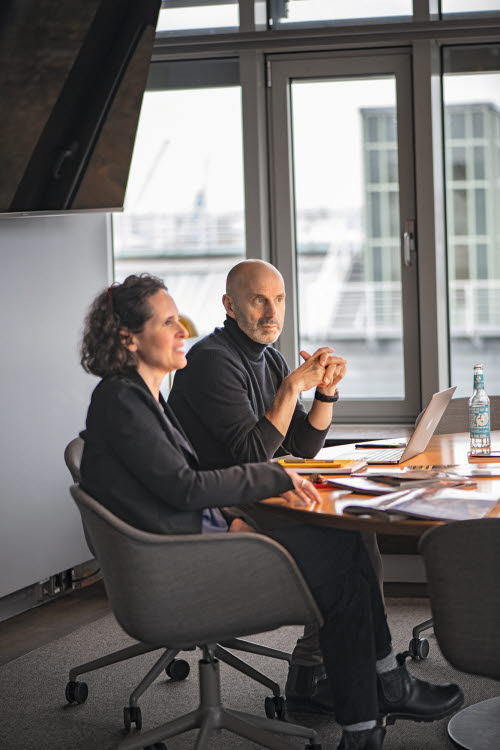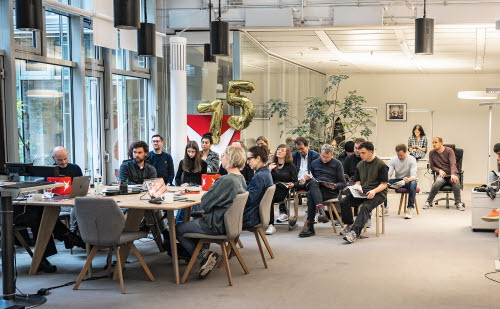This is an excerpt from the article "Giuseppe di Grazia & Cornelia Fuchs, two shining stars of Stern", which was printed in our magazine PAPER #7.
“The big difference between a print newspaper and digital is curation. Here you buy a curated, perfectly composed magazine that is well thought out from start to finish."
Stern’s headquarters could be said to be at the epicentre of the German and European media landscape. In addition to Stern, heavyweights like Der Spiegel and Die Zeit also have their editorial offices just a stone’s throw away. For decades, these three weekly magazines have both competed with, and inspired each other to deliver top-notch journalism with the best stories every week.
It began with 16 pages in 1948
“This week and over the past year, we’ve had several stories where people said, ‘Wow, Stern has that, Der Spiegel doesn’t, nor does Die Zeit.’ It hasn’t always been like this, but in the past year, we’ve really managed to publish issues with truly good and exclusive stories,” says Giuseppe di Grazia, deputy editor-in-chief of the printed magazine. Alongside Cornelia Fuchs, responsible for digital subscriptions, he leads the daily work at the magazine’s editorial office.

For Stern, the journey began with a thin 16-page issue that first saw the light of day in 1948. Shortly thereafter, it became Europe’s largest illustrated magazine. Over time, Stern has become an established part of German society, coming out every Thursday, and today filled with around 100 pages. An institution, one could say, that has shaped and portrayed the last few decades in Germany.
Always close to its readers
Not all magazines can look back on a 75-year history. So, how has Stern managed to remain relevant? The answer comes as swiftly as it does surely from di Grazia. “We’re close to our readers. We’re interested in people, always close to them, and we try to tell their stories.” His quick analysis is echoed by Fuchs, who believes that has been the core of Stern since its first issue. “I think that part of the recipe for success is how Stern came about. Founder Henri Nannen already had a good sense of what resonates in society. In the 1970s and 80s particularly, Stern was also part of many societal discussions. The editorial team always saw itself as a mouthpiece for progressive ideas,” she says.
Over the years, Stern has taken a stance on various issues, from the right to abortion to changes in policy towards East Germany during the years of Germany’s division.
A large photo department
In addition, Stern has always had an advantage over its competitors – photojournalism. “Pictures have always played a crucial role at Stern, from a time when there weren’t many of them to today, when they overwhelm us. Pictures are still something authentic, and that’s why we have a large photo department that carefully evaluates the material,” says Fuchs.
This means, among other things, that the editorial team demands that photographers deliver the original files of the images and has strict rules for what the concept of “image processing” allows. Stern has also adhered to the principle of a close collaboration between journalist and photographer to create reports that are a symbiosis of text and image. The result is a classic type of photojournalism that has become increasingly rare in today’s media world.
“I don’t think there is any other magazine today that still works so closely with photographers. In the foreign section in particular, we have many photographers who have worked for us for years, especially in war zones,” says di Grazia.
Paper to do the material justice
A strong focus on images also places high demands on the paper to do justice to the material.
There are three criteria that must be met for the quality we want to deliver. A good story, good pictures and good paper.
Stern is printed today on Holmen UNIQ 47 gsm, and both di Grazia and Fuchs argue that paper quality plays a crucial role in readers’ decision to buy Stern.
“There are three criteria that must be met for the quality we want to deliver. A good story, good pictures, and good paper. Yes, the printing, too, of course,” says di Grazia. “We have a paper purchasing production department with colleagues who negotiate with Holmen, showing us samples and explaining the advantages of different papers for our printing and our images.”
Climate footprint also influences the choice of paper. Stern, like all titles within the publishing house, has a goal to reduce carbon dioxide emissions by 60%. The choice of paper and how it is manufactured play a significant role.
Print and digital editions work together
Stern has existed for a long time as Stern Online. But until quite recently, and longer than many other media houses, the main focus was on the print edition. “We still made a lot of money selling the newspaper and on ads. Both we and other publishers also long believed that German readers weren’t ready to pay for a digital subscription in the same way as in the USA or Scandinavia,” says di Grazia.
In hindsight, Stern waited a little too long to invest in the digital realm. Therefore, there is now a massive effort to launch a new digital service that combines content from both Stern and other titles within the publishing house. But despite this, the print edition continues to play a crucial role. Not least as an alternative to both Stern’s own and all other digital offerings.

“The big difference between a print newspaper and digital is curation. Here you buy a curated, perfectly composed magazine that is well thought out from start to finish. It has a solid structure where you can continue reading at home where you left off on the subway. Digital content isn’t curated. There is so much the reader has to do if it’s not done with algorithms,” says Fuchs.
Of course, they both understand that we live in a digital world, but they’re also convinced that there is a place for a well-produced paper magazine like Stern. Both now and in 10 years’ time. “I also think it’s becoming even more important for many people today with all the screens that surround us. Digital is very ephemeral and a printed copy of Stern on the coffee table is a completely different experience,” says Fuchs.

